Betel Nut (Areca catechu) Uses, Research, Medicines, Side Effects
Betel nut – Areca catechu is an Ayurveda herb mentioned for the treatment of mouth ulcers, leucorrhea, dental plaque, joint pain, diarrhea, intestinal worms and excessive urination.
Latin name – Areca catechu Linn.
Family – Palmae/ Arecaceae (Narikela kula)
Table of Contents
Introduction
Betel nut is from Cochin. It is widely found in china and Malaya. Its name Areca is translation from Malaya word. It was referred in many of our ancient books, mythologies and classics. It was considered a sacred nut offered while welcoming a guest.
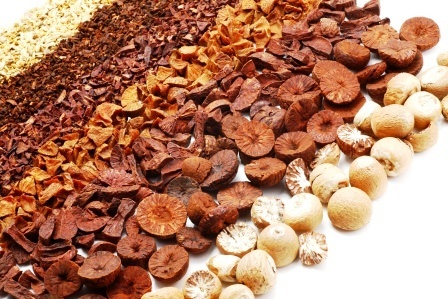
Areca is said to be a latinized form of the Malayan name. It has references in many of our ancient books, mythologies and classics. It was considered as a sacred nut offered while welcoming a guest.
Uses of Puga
Decoction of Puga is used for gargling to treat cases of mouth ulcer, bleeding gums and dental plaque.
Fine powder of areca nuts is used as dusting powder to treat wounds and control bleeding.
The decoction of areca nuts is given in a dose of 10 ml to treat intestinal worms and diarrhea.
The decoction of Areca catechu is pushed through the vaginal route as a type of enema to treat the condition of leucorrhea.
Sesame oil processed with areca nuts is used for external application over joints affected with pain and inflammation.
Areca nut powder in a dose of 1 – 2 g mixed with lime juice is given to treat anorexia and nausea.
The powder of Areca catechu is used as dental powder to whiten the teeth and remove dental plaque.
Regular intake of areca nuts can cause a decrease in sperm count.
Decoction of puga in a dose of 10 – 15 ml can treat inflammation of the uterus and decrease the urine output.
Ayurveda explains the use of tambula (mixture of betel leaf, areca nut and some spices) after meals to aid in digestion of food.
To treat syphilis, the paste of areca nut is applied over the affected area.
Boiling the areca nut will reduce the strength of the nut which can be later used for mouth freshners.
Uttara Basti (Vaginal douche) is administered in case of Leucorrhoea.
A dusting of powder is suggested for wounds and ulcers
The gargle of pugaphala is taken in diseases of the mouth particularly stomatitis, throat infections and the decoction of nuts is used.
The oil prepared with puga is applied in backache, waist pain and vata vyadhi.
The powder of nuts, mixed with lime juice / milk is good for anorexia, diarrhea, dysentery and worms.
Seed of areca together with lime, black catechu and leaves of betel are useful in the decay of teeth.
Powder of dried nuts in 10-15 grains along with equal parts of sugar will cure diarrhea due to debility.
¼ th tola powder rubbed into a paste with 2 tola of fresh lemon juice makes an excellent vermifuge. About a teaspoonful is administered after the patient has fasted for 12-14 hrs either up to a bolus with a ghee / floating on milk. Useful in roundworm and tapeworm, 4.6 grams of powder stirred with 2-3 ounces of milk is useful for expulsion of tapeworm.
Tincture forms an astringent gargle when freely diluted with water i.e. 1 gram of powder with 4 ounces of water, useful in bleeding gums. It is also used as an injection for stopping watery discharges from the vagina and in checking pyrosis of pregnancy.
Nut burnt to charcoal and quarter part of cinnamon forms tooth powder.
Juice of tender leaves mixed with oil is applied as an embrocation in cases of Lumbago.
Decoction of root is a repeated cure for sore lips.
In Rakta pitta, supari churna with sandalwood powder equal quantity should be taken with rice washed water and honey.
In Vata vyadhi, shallaki along with areca nut tea are mixed with oil and given to drink.
In Upadamsha, supari is rubbed and crushed and paste is done.
In bleeding disorders (Rakta pitta), areca nut powder should be mixed with sour fruit juices and administered as enema or given orally.
Dusting of supari is done for quick wound healing. Being an astringent, it absorbs slough and wound liquids.
In Dysuria, water boiled with areca
In cough, betel nut chewed along with leaves of betel climber.
1 g powder of areca along with 1 cup tepid warm milk, brings back the ability to sexual pleasure.
Boil 4 g of nuts; 3 cups of water and then it is reduced to 1 cup; 2 parts of it are taken daily twice in blood dysentery and indigestion.
Tender Areca Nut Tea for Wound Care
Dr MS Krishnamurthy MD(Ayu) PhD.
I have seen plenty of patients of non healing ulcers or chronic ulcers often oozing with pus or associated with serous discharge or bleeding, sometimes associated with itching.
The following decoction (herbal tea) with very tender Arecanut (green colored) is highly useful to wash the wounds and ulcers.
Ingredients
10-12 very tender Areca nuts
2-3 pinch of turmeric powder
A pinch of Table salt and
5-10 ml of honey.
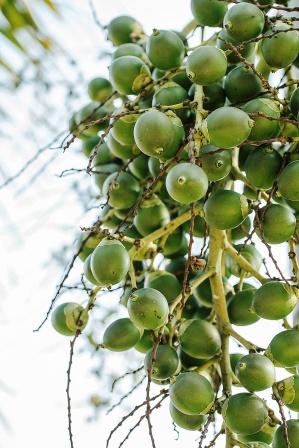
Method of preparation
Method of preparation of washing solution:
a dozen of tender betel nuts are crushed well and added to 2 Liters of water and boiled.
This is carried till it turns into dark brown colored solution or the amount reduces to about 1 Liter.
This is filtered and to this filtrate turmeric powder, powdered salt and 5-10 ml of honey are added and mixed thoroughly.
When the solution is lukewarm. It is used for washing the wounds. Even this can be used to soak the wounded area/ulcer for 5 – 10 minutes of time.
Mode of action
Rationality – How does it act?
Areca nut (Areca catechu) possesses bitter and astringent principles and alkaloids like Arachic acid; this helps in preventing super infections. Turmeric is a well-known antiseptic herb and wound healing agent.
Read related: Turmeric: Curcuma longa Benefits, Usage, Dose, Side Effects
Salt helps in maintaining the pH of the solution; even if the decoction is kept for 3-4 hours, the potency of the solution is maintained well. Honey is a fit ingredient and age old drug to check the oozing and to reduce the infections. Also it accelerates the healing process.
Read related: Honey: Qualities, Usage, Remedies, Ayurvedic Benefits
What can be done if fresh or wet/ tender betel nut is not available?
TThe dry Areca nut powder also possesses the same action and hence it can be used. But, better to soak the powdered Areca nut for 1-2 hours in water and thereafter to use for cooking on fire. But it is surely next to tender Areca nut in therapeutic benefits.
Note: The ripened Areca nut does not possess this potent healing property and hence its usage is not substantiated.
Further uses
Scope for further uses:
I have witnessed the excellent effect of this decoction even in cases like ulcers caused by the snake bites. Earlier Mr (Late) Kanale Krishnamurthy from Sagar, Shivamogga, Karnataka used to practice this decoction in hundreds of patients. He had documented successful usage of this decoction (along with few oral medicines) in the treatment of necrosed skin lesions too.
I dedicate this Article for the Noble ideology of Late Kanale Krishnamurthy (Sagar).
Click to consult Dr MS Krishnamurthy MD (Ayu) PhD.
Sanskrit verse
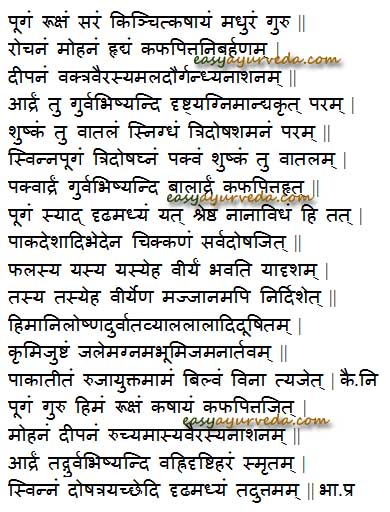
Properties, part used, dosage
Properties:
Rasa (Taste) –Kashaya (Astringent), Madhura (Sweet)
Guna (Qualities) – Guru (Heavy for digestion), Ruksha (Dry in nature)
Vipaka – Katu (Undergoes pungent taste after digestion)
Veerya (Potency) – Sheeta (Cold)
Karma (Actions) – Kapha Pitta shamak (reduces vitiated kapha and pitta dosha)
Part used – Fruit, Seed
Dosage –
Powder or cut seed – 1 to 3 g
Decoction – 10 to 15 ml
Read related: Tender Arecanut Herbal Tea For Wound And Ulcer Care
Qualities as per Bhojana Kutuhalam
Rasa (Taste) – Astringent
Virya (Potency) – Cold
Guna – Rooksha (Dry)
Alleviates – Kapha and Pitta, intoxicating, stimulates digestive fire, improves taste perception, removes bad taste from the mouth.
Pharmacological actions – Anti bacterial, Anti fungal, Sedative, Abortifacient, Hyperglycemic, Anti fertility
Wet and boiled arecanut
The wet arecanut is heavy for digestion and blocks the channels, weakens the digestive fire and hampers vision. Boiled arecanut destroys all the three doshas, The wet arecanut with the strong middle portion is said to be the best.

Chemical composition
Chemical composition of Areca catechu:
Areca nut contains tannin, a fixed oil, gummy substance, a volatile oil, lignin 15%, a red coloring substance areca red and several alkaloids. It has 31.31% moisture, 4.9% protein, 4.4% fat; 11.2% fibers, 47.2% carbohydrates and 1.0 g/100mg minerals. The mineral constituents present are 50% calcium, 130% phosphorus, 1.5% iron, 286.9% vitamin B6, 416.2 mg/100g of vitamin C. The carotene and calorific values are 3ug/100g and 249 kcal/100g. The fatty acid constituents of oil are lauric 19.5, myristic 46.2, palmitic 12.7, stearic 1.6, decanoic 0.3, oleic 6.2. linoleic 5.4, dodecenoic 0.3. The chief component glycerides are 56% fully saturated (trimyristin) 30% mono – unsaturated di saturated and 14% di unsaturated – monounsaturated.
The alkaloids present belong to the pyridine group; they are arecaidine, areolidine, guvacine, guvacoline, isoguvacine, norarecaidine and norarecoline. The amino acids present are traces of tryptophan, methionine and larger amounts of proline tyrosine, phenylalanine and arginine.
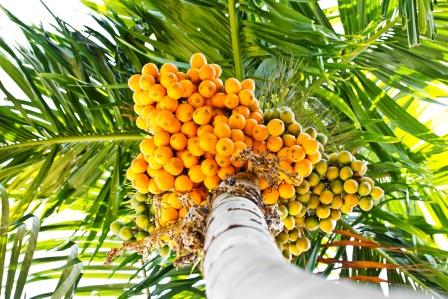
Leaf contains eugenol, hydroxy chaercol, carotene, vitamin C, vitamin B6, phenylalanine, bioactive polyphenolic components like NPF – 861A, NPF – 861B, catechin, epicatechin.
Traditional uses, Indications
Traditional uses as per Ayurveda:
Unripe arecanut – Ama Pooga –
Kashaya – astringent
Mukha mala shamana – cleanses oral cavity and feces
Kanthashuddhi – cleanses throat
Useful in Rakta, Kapha and Pitta disorders.
Sara – induces mobility, causes diarrhea, purgation, relieves constipation
Indicated in
Udara – ascites, enlargement of the abdomen
Adhmana – bloating, gaseous distension of abdomen
Dry Arecanut –
Rooksha – dry
Guru – heavy to digest
Sara – induces mobility, causes diarrhea, purgation, relieves constipation
Rochana – improves taste, relieves anorexia
Mohana – causes relaxation
Hrudya – acts as cardiac tonic, congenial for heart
Hima – coolant
Balances Kapha and Pitta Dosha
Deepana – improves digestion strength
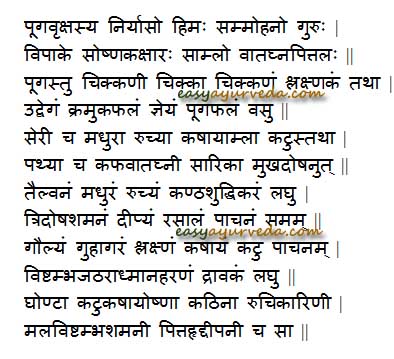
Indicated in –
Vaktra Vairasya – bad breath. foul smell
Mala Daurgandhya – foul smelling feces
Wet, fresh arecanut –
Guru – heavy to digest
Abhishyandi – sticks to the inner channels
Drusthimandya krut – causes eye disorders
Agnimandyakrut – causes weak digestion
Dry arecanut slightly increases Vata, but Tridoshahara – Balances all the three Doshas
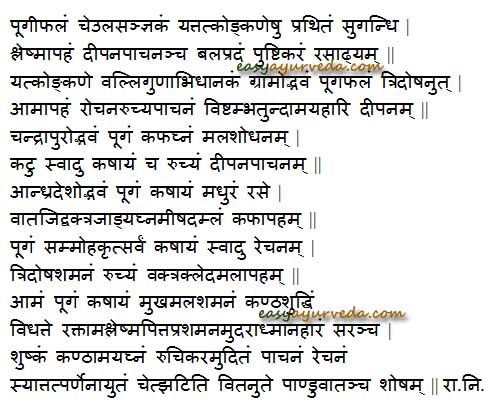
Swinna Pooga – boiled arecanut –
Tridoshaghna – balancing all the three Doshas
Ripe and dry fruit increases Vata Dosha.
The betel nut that is hard in the middle and has shine, is very good for consumption.
Pooga niryasa – exudate from the betelnut plant –
Hima – coolant
Ushna – hot
Kshara – alkaline
Amla – sour
Balances Vata, increases Pitta
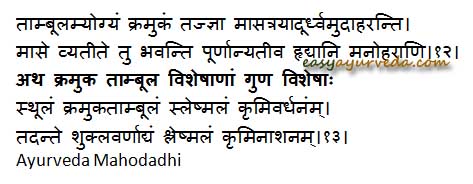
Ideal betel nut
Ideal betel nut for making pan:
As per Ayurveda Mahodadhi, the areca nut used for the purpose of tambula should be at least 3 months old. The nut that exceeds the third month will have the constituents of arecanut in their fullest form and is considered to be cardiac and pleasant to mind.
Ideal betel nut size:
The stout variety of arecanut is considered to increase the kapha doSha and manifest the worms in the intestines.
Whereas the white variety of the arecanut increases the kapha doSha is considered to eradicate the intestinal worms.
Adverse effect
Increased intake of puga can cause dizziness, nausea and unconsciousness. Intake of water or oily substances like butter or ghee can reduce the adverse effect.
Interaction with medicines, supplements
Can this be used while taking Homeopathic medicine?
Yes. This product does not react with homeopathic medicine.
Can this medicine be continued while taking supplements like multivitamin tablets, Omega 3 fatty acids etc?
Yes. Generally, this product goes well with most dietary supplements. However, if you are taking more than one product per day, please consult your doctor for an opinion.
With western
medicines
Seek your
doctor’s advice if you are taking this product along with other western
(allopathic / modern) medicines. Some Ayurvedic herbs can interact with modern
medicine.
If both Ayurvedic and allopathic medicines are advised together, then it is
best to take Allopathic medicine first, wait for 30 minutes and then take the
Ayurvedic medicine.
Ayurveda medicines
Ayurveda medicines containing Puga:
Phuga khanda: It is used in the treatment of vomiting, gastritis, dyspepsia, abdominal colic pain, dizziness, rheumatoid arthritis, diabetes, obesity, splenic disorders, rectal bleeding, anemia.
Balanth khada No.3: It is a proprietary ayurvedic medicine which is administered from 21st day delivery to the 60th day post – delivery, to the nursing mother. It strengthens the abdominal muscles and ligaments attached to the uterus and Pelvis.
Dashan samskar churna: It is an Ayurvedic medicine in herbal powder form. It is used as tooth powder. It helps to strengthen teeth, improves shine and whiteness.
Research
Research articles related to Areca catechu:
Anti – microbial study: Varying concentrations of Areca catechu L.nut ethanol extract were tested for antimicrobial activity against 0.5 McFarland of mixed – oral flora and eight gram – negative clinical isolates (E. coli, K. pneumoniae, P. vulgaris, P. aeruginosa, S. non – typhi, S. typhi, S. flexneri and V. cholera) by agar well diffusion method. All concentrations were shown to inhibit growth in all mixed – oral flora models with zones of inhibition ranging from 7 mm to 18 mm. Susceptible patterns were also seen in all grams – negative clinical isolates with the smallest mean of zones of inhibition seen in Escherichia coli which is 8 mm at 30 % concentration and Klebsiella pneumoniae with no zone of inhibition in both 30% and 50% concentration.
Anti – fungal activity: The purpose of this investigation was to study the antifungal activity of hot water extract of Areca Catechu nuts collected from the coastal region of Kerala. The Areca Nut extract did not inhibit the growth of mycelial fungal forms such as Mucor sp, Aspergillus niger and Cladosporium sp but the growth of unicellular fungus Candida albicans was inhibited.
Anti – oxidant activity: The seed of Areca catechu contains higher proportions of polyphenolic compounds mainly tannins. Results shows that the methanol extract (ME) obtained from successive extraction has highest tannin content (TC), total phenolic content (TPC) and exhibited higher reducing power and hydrogen peroxide scavenging ability in comparison to petroleum ether, ethyl acetate and water extract (WE).
Anti – ovulatory and abortifaciant activity: For antiovulatory effect, ethanolic extract of A. catechu at 100 and 300 mg/kg doses was administered orally for 15 days. The extract of A. catechu showed a significant decrease in the duration of estrus at 100 mg/kg (P = 0.015) and 300 mg/kg doses (P = 0.002) as compared with control. Metestrus phase was also significantly reduced at 100 mg/kg (P = 0.024) and 300 mg/kg doses (P = 0.002). There was a significant increase in proestrus (P < 0.001) phase. However, the diestrus phase was unchanged.
Classical categorization
Bhavaprakasha – Amradi phala varga
Kaiyyadeva Nighantu – Oushadhi varga
Raja Nighantu – Amradi phala varga
Priya Nighantu – Haritakyadi varga
Scientific classification
Kingdom: Plantae
Order: Arecales
Family: Arecaceae
Genus: Areca
Species: A. catechu
Types
White Supari Prepared by harvesting fully ripe areca nuts and by sun drying for 40 – 50 days. After drying the nut, the shell of the has to be removed by hand machine and called as Supari
Red Supari Prepared by harvesting tender green areca nuts and peeling the husk, boiled in water and dried and known as Chikni Supari.
Types of Arecanut as per region:
Sreevardhan type – Grown in coastal Maharashtra
Mangala type – Grown in Dakshina Kannada
Sumangala type – Selection from Indonesia Average yield is 17.5 kg / palm at 10 years
Sreemangala – Selection from Singapore Average yield is 15.63kg/palm at 10th year
Mettupulayam – Grown in Coimbatore district of Tamilnadu
Mohitnagar – Largely grown in north eastern region like west Bengal
Kahikuchi – Grown in north eastern regions like Assam, Manipur, Mizoram, Tripur
Types Of Supari as per market:
Mora
Moti
Vachras
Jamnagar
Jini
Lindi
History and Ayurveda reference
Although Vedic texts mentioned Yajurveda kramuka tree as the personification of agni and said to be the product of agni. It is also told as a crown of leaves looking like an arrow stuck in the ground. It also emboized the bow kramuka was applied as samidha and homa dravya in sacrifices. It was said in the Kaushika Sutra that it removes the poison caused by serpent bites. The Satapatha Brahmana mentioned that when soaked in ghee and burnt Puga does not leave ashes thus people of ancient India were aware of the medicinal value of Puga.
Sushrutha said that it cures diseases of Kapha and acts on pitta and is also useful in cleaning the mouth in normal doses. In Brihat Trayi, Charaka, Astanga Hridaya is the only place mentioned about Puga. Charaka also said it cures diseases of blood. In the 4th century, Vagbhata explained the uses of areca nut in cases of Kusta, Kasa, Krimi.
In the 11th century Chakradutta, described the external application of Puga in small pox and chicken pox. In Kalpasutra, Panini’s Astha adhyay, Vaarthika Vishnu shasma’s Hetopadesh also there is mentioned about Puga. There is mention of Puga during the Mughal period. It is also mentioned in Raja Nighantu and Dhanvantari Nighantu varieties of Areca.
Vernacular names
Names in different languages:
Hindi name – Puga, Supari
English name – Areca nut, Betel nut, Arecanut palm, Betel palm, Catechu palm, Fauselnut, Pinang, supari palm
Assamese name – Tambul
Bengali name – Gua, Supari
Gujarati name – Hopari, Sopari
Kannada name – Adike, Adake, Adaki, Adike, Bettadike
Marathi name – Pophali, Supari, Poog
Malayalam name – Atekka, Pugam, Chempalukka, Pakka, Kramukam, Ghonta, kamuka, kavunnu
Tamil name – Paaku, Kugagam, Pugam
Telugu name – Kramukamu, Pugamu
Urdu name – Supari, Feefal
Arabic name – fofal, feefal
Burmese name – Kun, Kunsi
Chinese name – ping lang
Italian name, Portuguese name – areca
German – areca palm
Dutch name – arecapalam boom, pinang
Russian name – areka, kapustnaya palma
Tulu name – Kangu
Read related: Tambul – Pan Chewing – Right Method And Benefits
Sanskrit Synonyms
Kashayaphalapushpaka – betel nut fruit and flower are predominantly astringent in taste
Deergha Padapa – tall tree
Valkataru, Valkachikkana – shining bark
Kramuka – Puga subside kapha and pitta dosha
Guvaka – Puga act as sramsaka
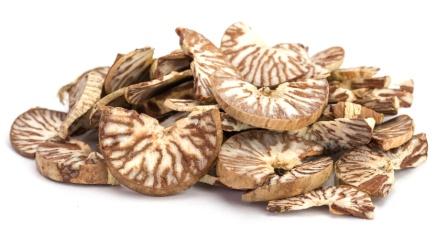
Chikka, Chataphala, Kramuka, Guvak, Valkataru, Rajaphala, Tambula, Udvega
Kramuka, Kebuka, Sramsi, Ghonta Phala, Khapura
Puga, Pugaphala, Poogaka, Poogi,
Chikkana , Chikka, Guvachika, Ghoranta, Drudhahvaya, Munihvaya
Morphology
Morphology of Areca catechu:
Areca tree is found and cultivated for its commercial value in the southern states of Karnataka, Kerala, Andhra Pradesh and in North Eastern states of Assam. The tree grows to a height of 12 – 20 m. and has a diameter of 10 – 15 cm. It is tall, slender & unbranched surmounted by a crown of pinnate leaves. The leaves are 4 – 6 feet long, fan type feathers like dropping leaves often confluent & glabrous. Leaflets are numerous and 30 – 60 cm long. The female flowers are solitary or in groups or 2 or 3 at or near the base of each ramification of the spadix sessile, much larger than male, The fruits are 3.8 – 5 cm long, smooth, ovoid or oblong, green in unripe stage and nuts orange or reddish color in refined matured stage. Inside the fruit is a single seed. Endosperm is popularly called the areca nut, which is 2 – 4 cm in diameter grayish brown, with reddish brown lines.
Author: Dr.B.K.Prashanth M.D (Ayu), Ph.D
E mail: drprashanthbk@gmail.com
Click to consult Dr Prashanth BK
Sthanika Karma (Systemic Action)
External application
Promote faster wound healing. Decoction can be given for gargling in stomatitis, toothache, throat diseases. Decoction is used for uttara basti and for pichu in Leukorrhea. Powder is used to sprinkle on wounds and promotes faster healing. Oil prepared out of it can be used for external application in Low back ache and diseases of vata origin.
Internal administration-
Nervous system – strengthens the nervous system, Indicated in vataja rogas
Digestive System – Stimulates the production of salivary juice thus helps to prevent bad breath. Fruit is carminative, improves taste, mouth cleanser, and is of a styptic nature. overdose can increase peristalsis movement and cause abdominal discomfort. Indicated in Anorexia, Helminthiasis, Diarrhea, Dysentery. Seed powder along with lime juice and milk is effective for worm infestation.
Respiratory system – Causes bronchoconstriction.
Circulatory system – Indicated in bleeding disorders
Reproductive system – Sukrasthambaka and is indicated in inflammatory conditions of the uterus, Sukrameha and in svetapradara (Leukorrhea).
Excretory system – decreases the urine output
Satmikarana – Indicated in animal poisoning, facture, wounds etc.
Tvak – increases sweat production
Satmikarana – Ojonasaka, causes tissue destruction. Over consumption can cause dizziness









9 comments
Dr. Ramesh Balcrishna Bhonsle
The information is very good. But I would like to inform you that chewing areca nut in any form causes debilitating disease called oral Submucous Fibrosis and hence should discourage its use.
Thanking you
vijet hegde
bhonsle saab agar had se zyaada ho to amrit bhi vish ban jaaata hai ati sarvatra varjayet 🙂
Vikas
Rightly said, moreover, in many Indian homes, Betel nut powder mixed with some 2-3 other ayurvedic herbs is given to Postpartum women. It is said to be extremely beneficial for postpartum. The western education system disapproves everything that is taught in other countries. Slowly, they are coming to terms with Yoga and Ayurveda. Let’s see if they learn.
Viswanaath VS
Dear Doctor Hebbar, the general tamil name used for Areca Nut is “Paakku”. the names you have listed at the best, may be ancient names (which many won’t even know) or at the worst may be the wrong terms. Kindly amend your web page pls.
Dr J V Hebbar MD(Ayu)Author
Done!
Thank you very much for your kind help sir.
Dr. Ankita M
Thank you sir for the wonderful info on Puga…Can u kindly illustrate the point of its anti-helmentic property
Dr J V Hebbar MD(Ayu)Author
The decoction of areca nut is given in a dose of 10 ml to treat intestinal worms and diarrhea.
Vagbhata told the uses of areca nut in cases of Kusta, Kasa, Krimi.
savita upanal
sir can you tell me the properties of puga pushpa ?I
Dr J V Hebbar MD(Ayu)Author
Astringent and coolant.